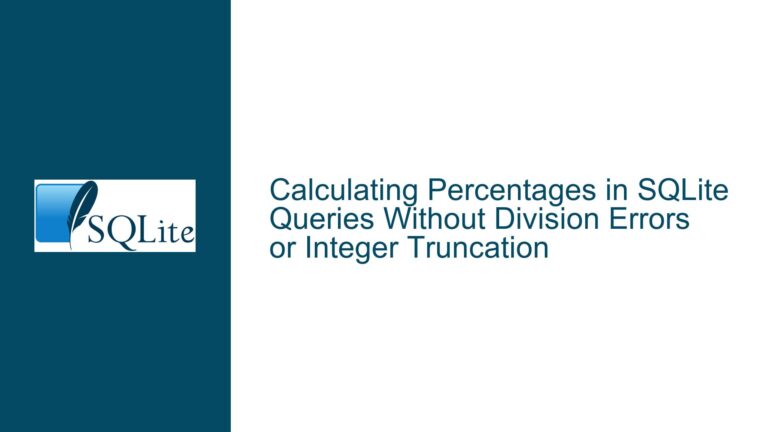Restarting Counters in SQLite Based on Another Field
Restarting a Counter Based on a Field in the Same Table
In SQLite, a common requirement is to generate counters that depend on the values of other fields within the same table. Specifically, the problem involves creating two counters: one that increments based on a distinct value in a field (e.g., P), and another that restarts whenever the first counter increments. This scenario is often encountered in data processing tasks where hierarchical or grouped numbering is required. For instance, you might need to assign a sequence number to records within a group and restart the sequence whenever a new group begins.
The challenge lies in the fact that SQLite does not natively support complex window functions or procedural logic without the use of advanced SQL constructs. However, with the right combination of SQL functions and windowing capabilities, this problem can be elegantly solved. The key is to leverage SQLite’s support for window functions, such as DENSE_RANK() and ROW_NUMBER(), which allow for partitioning and ordering of data within a query.
To illustrate, consider a table T with fields P and S. The goal is to generate two counters: C1, which increments based on the distinct values of P, and C2, which restarts at 1 whenever C1 increments. The desired output would look like this:
| P | S | C1 | C2 |
|---|---|---|---|
| ABCDE | A | 1 | 1 |
| ABCDE | B | 1 | 2 |
| ABCDE | C | 1 | 3 |
| ABCDE | D | 1 | 4 |
| ABCDE | E | 1 | 5 |
| XYZ | X | 2 | 1 |
| XYZ | Y | 2 | 2 |
| XYZ | Z | 2 | 3 |
This output demonstrates that C1 increments only when the value of P changes, while C2 restarts at 1 for each new value of P.
Interrupted Write Operations Leading to Index Corruption
The core issue revolves around the need to generate sequential counters that are dependent on the values of another field within the same table. This is not a straightforward task in SQLite due to its limited support for procedural logic and complex window functions. However, the problem can be broken down into two main components: generating a counter that increments based on distinct values of a field, and generating a counter that restarts whenever the first counter increments.
The first counter, C1, can be generated using the DENSE_RANK() window function. This function assigns a unique rank to each distinct value of P, ensuring that the counter increments only when P changes. The second counter, C2, can be generated using the ROW_NUMBER() window function, which assigns a sequential number to each row within a partition defined by P. This ensures that C2 restarts at 1 whenever C1 increments.
The challenge here is to ensure that the counters are correctly calculated and displayed in the desired format. This requires a deep understanding of SQLite’s window functions and how they can be combined to achieve the desired result. Additionally, it is important to ensure that the query is optimized for performance, especially when dealing with large datasets.
Implementing DENSE_RANK() and ROW_NUMBER() for Counter Generation
To solve the problem of generating the counters C1 and C2, we can use the following SQL query:
SELECT P,
S,
DENSE_RANK() OVER (ORDER BY P) AS C1,
ROW_NUMBER() OVER (PARTITION BY P ORDER BY S) AS C2
FROM T
ORDER BY P, S;
This query uses the DENSE_RANK() function to generate the C1 counter, which increments based on the distinct values of P. The ROW_NUMBER() function is used to generate the C2 counter, which restarts at 1 for each new value of P. The PARTITION BY clause ensures that the ROW_NUMBER() function operates within each partition defined by P, while the ORDER BY clause ensures that the rows within each partition are ordered by S.
The DENSE_RANK() function assigns a unique rank to each distinct value of P, ensuring that C1 increments only when P changes. The ROW_NUMBER() function assigns a sequential number to each row within the partition defined by P, ensuring that C2 restarts at 1 for each new value of P.
To further optimize the query, we can add an index on the P and S fields. This will improve the performance of the query, especially when dealing with large datasets. The following SQL statement creates an index on the P and S fields:
CREATE INDEX idx_P_S ON T(P, S);
This index ensures that the ORDER BY clause in the window functions operates efficiently, reducing the time required to generate the counters.
In addition to the query and index, it is important to consider the impact of data modifications on the counters. If new rows are inserted into the table T, the counters may need to be recalculated. To handle this, we can use a trigger to automatically update the counters whenever a new row is inserted. The following SQL statement creates a trigger that updates the counters whenever a new row is inserted into the table T:
CREATE TRIGGER update_counters AFTER INSERT ON T
BEGIN
UPDATE T
SET C1 = (SELECT DENSE_RANK() OVER (ORDER BY P) AS C1),
C2 = (SELECT ROW_NUMBER() OVER (PARTITION BY P ORDER BY S) AS C2)
WHERE rowid = NEW.rowid;
END;
This trigger ensures that the counters are automatically updated whenever a new row is inserted into the table T. The NEW.rowid keyword refers to the rowid of the newly inserted row, ensuring that only the counters for the new row are updated.
In conclusion, the problem of generating counters that depend on the values of another field within the same table can be solved using SQLite’s window functions. By combining the DENSE_RANK() and ROW_NUMBER() functions, we can generate the desired counters C1 and C2. Additionally, by creating an index on the relevant fields and using a trigger to automatically update the counters, we can ensure that the solution is both efficient and robust.






